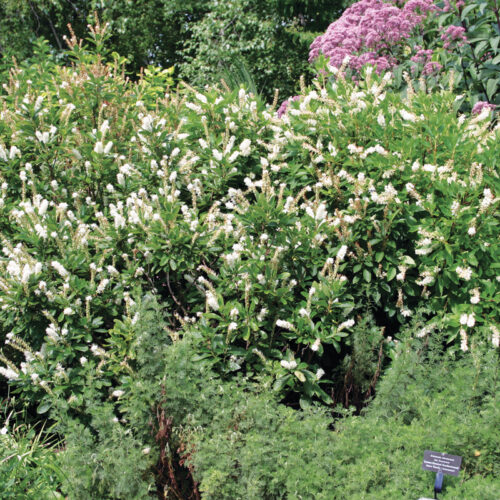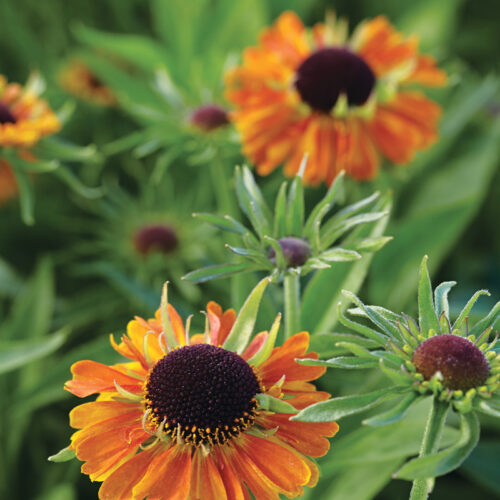This plan represents a bed along a property fence between the west side of a house and a large canopy tree. The edge of the border is curved because I find that adds visual interest. This plan includes many plants that are adaptable to sun and shade as well as some supporting players that add interesting textures and forms to the design and that provide repetition and rhythm. The plants are placed according to their needs.
Those that can take more heat, such as ‘Lightning Strike’ feather reed grass, are placed on the west side of the house.
Plants that handle drought, such as ‘June’ hosta, are placed under the canopy, where they can compete with the root system of the tree.
Moisture lovers are at the center, where excess rain from the roof can pool. Plants such as ‘Berry Awesome’ hibiscus are placed here because they are adaptable to wetter conditions.
Some species are scattered everywhere, because they can take heat, drought, wetness, sun, and shade. These include Proud Berry® coralberry and ‘Autumn Magic’ black chokeberry.
|
1 Proud Berry® coralberry
|
2 ‘Pearl Frost’ Japanese orixa
|
|
3 ‘Autumn Magic’ black chokeberry
|
4 Summersweet
|
|
5 ‘Berry Awesome’ hibiscus
|
6 Three-flowered maple (Acer triflorum, Zones 4–7)
|
|
7 Henry’s lily
|
8 ‘June’ hosta (Hosta ‘June’, Zones 3–8)
|
|
9 ‘Blackhawks’ big bluestem (Andropogon gerardii ‘Blackhawks’, Zones 3–9)
|
10 ‘Short ’n’ Sassy’ sneezeweed
|
|
11 ‘All Gold’ Japanese forest grass (Hakonechloa macra ‘All Gold’, Zones 4–9)
|
12 Prairie dropseed (Sporobolus heterolepis, Zones 3–9)
|
|
13 Giant coneflower (Rudbeckia maxima, Zones 4–8)
|
14 ‘Lightning Strike’ feather reed grass (Calamagrostis ‘Lightning Strike’, Zones 4–9)
|
|
15 ‘Shrimps on the Barbie’ pulmonaria
|
16 ‘Southern Cross’ ironweed (Vernonia ‘Southern Cross’, Zones 4–9)
|
|
17 ‘American Goldfinch’ baptisia (Baptisia ‘American Goldfinch’, Zones 4–9)
|
18 ‘Lemon Queen’ helianthus (Helianthus ‘Lemon Queen’, Zones 4–9)
|
| DESIGN |
Tips for designing in transitional zones
Create a smooth transition.
This requires first researching the growth requirements of the plants you plan to use and making sure they include the full range between shade and sun. Full-sun and full-shade plants are the easy ones to place. However, to bridge the gap between the two extremes, you’ll also need plants that are designated partial shade and shade tolerant. You may not necessarily have all of those conditions, so adjust accordingly.
Select similar plants for both areas.
Choose plants in each of the categories that demonstrate similarities in structure, texture, form, and color. Those elements will create cohesion throughout the space. You may be using different plants for each lighting condition, but contrast coarse foliage with fine; utilize similar architectural forms; add plants that take a wide range of conditions; and use design elements such as balance, repetition, and proportion to pull everything together.
Remember that some species look different in sun and shade.
If you use the same plant in both areas of a garden, it may show variation in appearance. Some hostas (Hosta spp. and cvs., Zones 3–9), for example, will exhibit a different color and texture based on the amount of light they receive. But with the plants mentioned in this article, the physical look won’t change. Rather, the size and the amount of flowering and fullness may vary.























